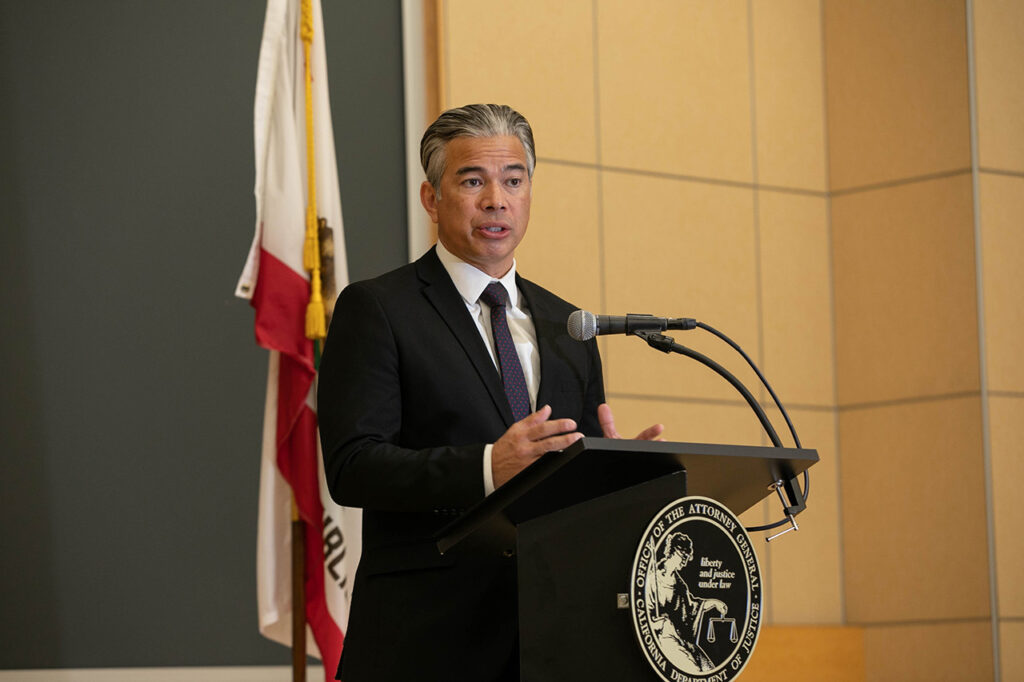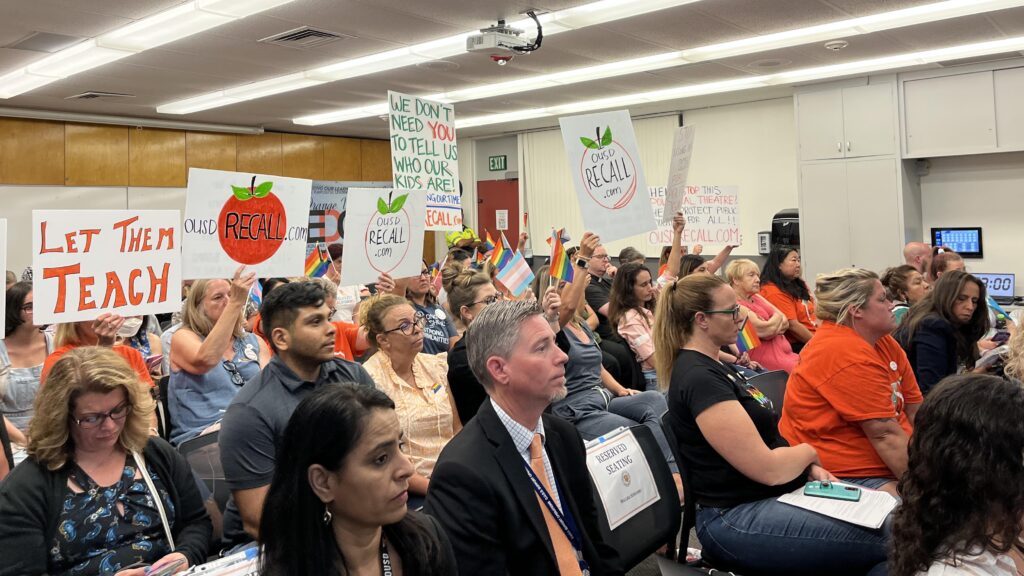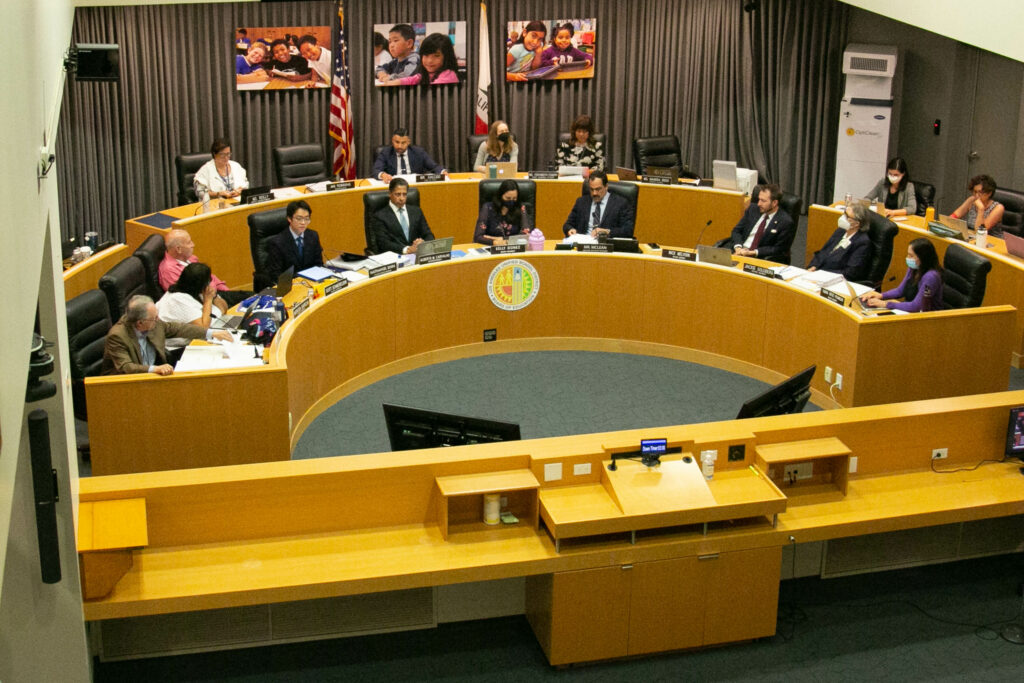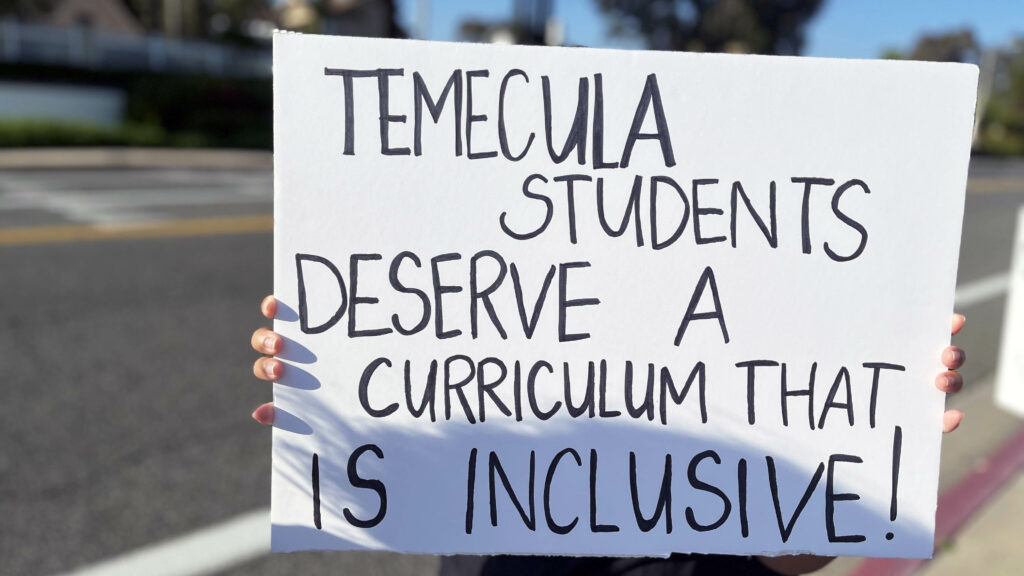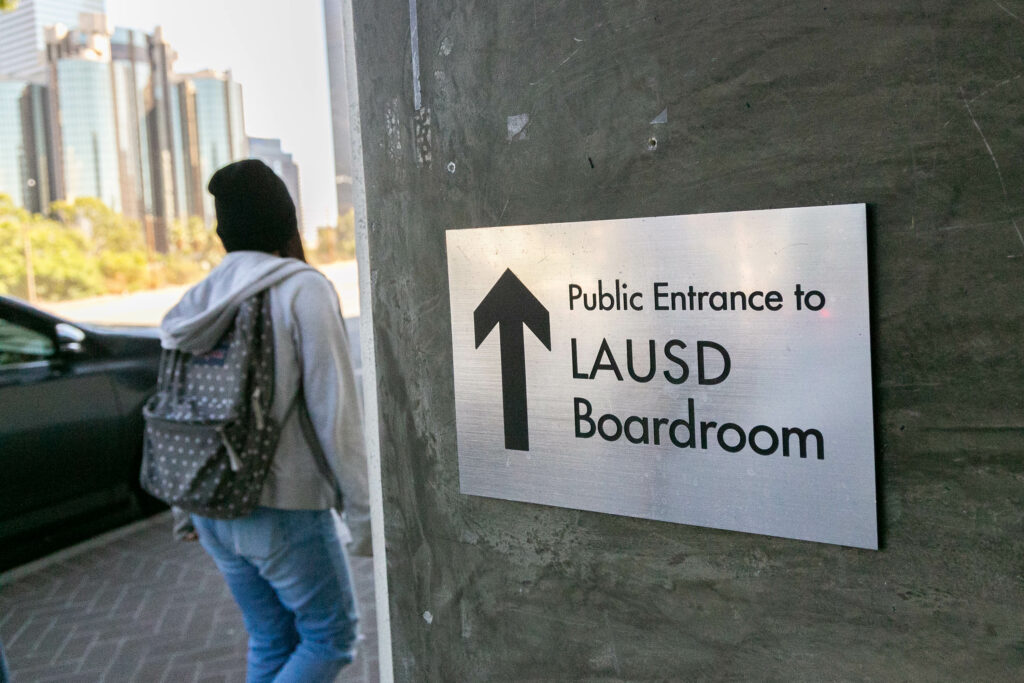
Credit: Julie Leopo/EdSource
The Los Angeles Unified School District school board is considering a resolution that would exclude 346 schools serving its most vulnerable student populations from co-location arrangements with charter schools. Doing so could potentially undermine the integrity of Proposition 39, a statewide initiative that mandates public schools to share spaces with charter schools.
The resolution, authored by President Jackie Goldberg and member Rocio Rivas and discussed at a meeting Tuesday, would require the district to avoid co-location offers on LAUSD’s 100 Priority Schools, Black Student Achievement Plan campuses and community schools.
According to the proposal, LAUSD would also avoid charter co-location offers that “compromise district schools’ capacity to serve neighborhood children” or “grade span arrangements that negatively impact student safety and build charter school pipelines that actively deter students from attending district schools, so that the district can focus on supporting its most fragile students and schools, key programs, and student safety.”
The proposed criteria would guide the placement of new charter schools as well as those opting to change location and increase oversight of charter school co-locations, including site visits before location offers are made, frequent assessments of the average daily attendance of charter schools as well as regular reporting of their facilities payments.
Goldberg said that her goal was not to “undo” anything but rather to prioritize the needs of vulnerable students by making the co-location process more rational.
“We should have just some accountability practices, a common sense policy,” said Gloria Martinez, treasurer of United Teachers Los Angeles, the teacher’s union. “I don’t necessarily see this as an erosion of charter schools to exist. This is not an attack on charter schools or communities or parents or students. This is simply saying ‘Our district schools are drowning, and what’s our life vest?”
Eric Premack, the president and founder of the Charter Schools Development Center, disagrees, saying, “That display at the board meeting today was really stunning, that they were essentially offering an extended middle finger to the voters of California, to the taxpayers and to students and parents and families who have opted to go to charter schools.”
Board members will vote on the resolution at Tuesday’s meeting. It would give Superintendent Alberto Carvalho 45 days to report back to the board with an updated co-location policy reflecting the resolution.
Charter school co-locations have long polarized the Los Angeles community with proponents of the proposed policy maintaining that sharing campus spaces has led to hostile environments for the children and greater challenges with securing necessary resources.
Charter proponents, on the other hand, say the resolution would cause even more of their campuses to be split up and prolong commutes for students who are already disadvantaged.
Still, the resolution comes amid years of declining enrollment across LAUSD, which some say might be the real reason behind the efforts to curtail co-location.
Charters in LAUSD: The Basics
For the 2023-24 academic year, Los Angeles Unified authorized 272 charters — 51 affiliated with the district and 221 independent, according to a presentation by José Cole-Gutiérrez, the director of LAUSD’s charter schools division, which coordinates the district’s Proposition 39 program.
By the first day of November each year, charter schools must file a facilities request to LAUSD as part of a process outlined by the proposition. Those requests must include the charters’ must include their average daily attendance, which is used to determine how much space they would be allocated.
For its part, LAUSD must extend a final location offer to the charters by April 1, and the charters have a month to respond.
For years, the district has had charters share campuses with its regular public schools. This academic year, there are 52 co-locations at 50 campuses, representing 6.7% of district sites.
Los Angeles Unified has seen fewer facilities requests from charter schools in the past few years. In the 2015-2016 academic year, for example, the district received 101 facilities requests. That number shrank to 51 this year.
‘More to do with less’: Fighting for increased enrollment
The resolution comes as Los Angeles Unified — and schools throughout the state — have been reckoning with decreased enrollment despite the expansion of transitional kindergarten. Districts are working harder to retain and increase their current student populations.
“Parents have some choices, and they’re not shy about exercising them,” said Premack, the president and founder of the Charter Schools Development Center. “A lot of them have voted with their feet and gone to the charter sector for instruction to enroll their kids, and … the district sees that is costing them a lot of money.”
Decreased enrollment has led to fewer charters making facility requests, leading to more physical space open for student learning, said Myrna Castrejón, president of the California Charter Schools Association, which opposes the proposed resolution and staged a rally outside LAUSD’s headquarters during the recent meeting.
With enrollment at 538,295 in 2022-23, LAUSD suffered the second-largest percentage enrollment decline in the state — a nearly 16% drop from 639,337 in 2015-16.
“The cream of the crop left the district and went to charter schools, so did the money, and so did the funds, now we have to do with less,” Rivas, who co-authored the resolution, said during Wednesday’s board meeting.
She also said that charter management organizations have continually profited while eroding the money the district needs to support more vulnerable student populations.
A study conducted by the University of Arkansas, however, found that regular public schools in LAUSD made $5,225 more per student than charters in the district, as of 2019-20.
“We’re pitted against each other to fight for the very few crumbs we’re given,” Rivas said.
Challenges with co-location
Parents and community organizations have long pointed to challenges with co-locating charters on regular LAUSD campuses, citing competition over spaces and contentious relationships between school communities.
“Co-locating charters are a burden placed on the shoulders of school communities. Campuses become divided spaces with drastically diminished resources, often at the expense of our most vulnerable students and families. As a result of co-locations, we have witnessed appalling and unacceptable uses of space,” reads a news release issued by the Facebook group Parents Supporting Teachers.
The group says some schools have had to hold speech therapy sessions in closets and auditoriums have been converted into administrative offices.
During Tuesday’s public comment segment, speakers and board members in favor of the proposed changes also cited challenges with district schools being able to access music and dance spaces — along with PE areas and rooms needed for individual education plan meetings.
Supporters of Los Angeles charter schools, however, emphasized that sharing spaces is not always associated with problems.
“Nobody likes to share,” said Castrejón, the president of the California Charter Schools Association. “But there are actually really good examples of … really good synergistic co-locations that actually amplify and serve both schools.”
Supporting campuses with higher needs
The new resolution would prevent Priority, Black Student Achievement Plan and community schools from sharing their campuses with a charter school. Board President Goldberg said during the meeting that the changes would offset “some of the worst impacts” of Proposition 39 on more vulnerable LAUSD schools and communities.
This academic year, LAUSD approved 13 co-locations on the district’s 100 Priority Schools, 19 co-locations on Black Student Achievement Plan campuses and seven on community schools campuses.
“We’re saying: Those schools where we are doubling our investment — and I don’t mean as far as dollars — but where we are doubling our efforts really to help those schools – we cannot subject them to being co-located and then having themselves … in a fight to be able to carry out that vision to be able to … hold on to rooms where we can actually carry out the needs of the community,” said Martinez, the treasurer of United Teachers Los Angeles.
The resolution’s opponents, however, have noted that many charters located on LAUSD campuses are community schools.
More than 70 of LAUSD’s independent charters have received State Community Schools Grants, according to Ana Tintocalis, California Charter Schools Association spokesperson.
“Based on CCSA’s analysis of the district data, there are more independent charter schools in LAUSD that have received State Community Schools Grants than district schools,” Tintocalis said in an email to EdSource.
Potential effects for charters
This academic year, 19 charter schools have been split over either two or three LAUSD campuses, and the proposed resolution is projected to increase that number.
“In attempting to avoid sites with special designations, it is likely that there will be more multi-site offers, leading to a larger overall number of co-locations Districtwide,” reads the interoffice correspondence from the office of the chief strategy officer on “Operational, Policy & Student Impact Statements” for the resolution.
“This may also lead to increased costs associated with renovation work to make sites ready for co-location, and would likely make it more challenging for the district when making ‘reasonable efforts’ to locate the charter school ‘near’ where it wishes to locate.”
Splitting a charter school across multiple sites can negatively impact students’ morale and can lead to unsustainable commutes for parents, said David Garner, the principal of Magnolia Science Academy-2.
“They were going to also offer us another school, which is Sepulveda Middle School, which is 6.9 miles away,” Garner said. “And 6.9 miles away is not a big deal if you have people that have cars. However, 88% of our students’ parents come from free-and-reduced lunch backgrounds.”
Eighty percent of the 4,000 students enrolled in his schools come from socioeconomically disadvantaged backgrounds.
Garner calculated that the commute from Sepulveda Middle School to Magnolia Science Academy-2 is 55 minutes each way by bus — which can add up, particularly in cases where parents have children at various locations, spread out across grade levels, with different bell schedules.
“Let’s just say one of the kids is in, you know, one of our sites on (Birmingham Community High School’s) complex, and then she has another two kids at the Sepulveda Middle School site,” said Garner.
“That parent would have to take the bus to Sepulveda from our school (at Birmingham) for one hour just to drop her other kids, and then take a bus back one hour to pick up the kid from our school, and then the bus back one more hour to pick up her second kid, and then the bus home.”
Ultimately, he said, schools — public, charter or private — should all be held to the same standards in supporting their students.
“We all take to this industry because we care about the kids,” Garner added. “We care about their futures. We believe that education can be used as a means to social mobility, as a means to get out of some challenging circumstances and (give) them all the tools to be successful.”

